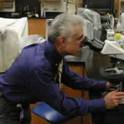
Article
Time course of resolution of adhesions during fibrinolytic therapy in tetracycline-induced pleural injury in rabbits
American Journal of Physiology - Lung Cellular and Molecular Physiology
(2015)
Abstract
The time required for the effective clearance of pleural adhesions/organization after intrapleural fibrinolytic therapy (IPFT) is unknown. Chest ultrasonography and computed tomography (CT) were used to assess the efficacy of IPFT in a rabbit model of tetracycline-induced pleural injury, treated with single-chain (sc) urokinase plasminogen activators (scuPAs) or tissue PAs (sctPA). IPFT with sctPA (0.145 mg/kg; n = 10) and scuPA (0.5 mg/kg; n = 12) was monitored by serial ultrasonography alone (n = 12) or alongside CT scanning (n = 10). IPFT efficacy was assessed with gross lung injury scores (GLIS) and ultrasonography scores (USS). Pleural fluids withdrawn at 0–240 min and 24 h after IPFT were assayed for PA and fibrinolytic activities, α-macroglobulin/fibrinolysin complexes, and active PA inhibitor 1 (PAI-1). scuPA and sctPA generated comparable steady-state fibrinolytic activities by 20 min. PA activity in the scuPA group decreased slower than the sctPA group (kobs = 0.016 and 0.042 min−1). Significant amounts of bioactive uPA/α-macroglobulin (but not tPA; P < 0.05) complexes accumulated at 0–40 min after IPFT. Despite the differences in intrapleural processing, IPFT with either fibrinolysin was effective (GLIS ≤ 10) in animals imaged with ultrasonography only. USS correlated well with postmortem GLIS (r2 = 0.85) and confirmed relatively slow intrapleural fibrinolysis after IPFT, which coincided with effective clearance of adhesions/organization at 4–8 h. CT scanning was associated with less effective (GLIS > 10) IPFT and higher levels of active PAI-1 at 24 h following therapy. We concluded that intrapleural fibrinolysis in tetracycline-induced pleural injury in rabbits is relatively slow (4–8 h). In CT-scanned animals, elevated PAI-1 activity (possibly radiation induced) reduced the efficacy of IPFT, buttressing the major impact of active PAI-1 on IPFT outcomes.
Keywords
- Fibrinolytic therapy,
- Fibrinolysis,
- plasminogen activator inhibitor 1,
- pleural injury,
- urokinase,
- tissue plasminogen activator
Disciplines
Publication Date
September 15, 2015
DOI
10.1152/ajplung.00136.2015
Publisher Statement
First published in the American Journal of Physiology - Lung Cellular and Molecular Physiology.
Citation Information
Azghani, A. O. (2015). 4. Time course of resolution of adhesions during fibrinolytic therapy in tetracycline-induced pleural injury in rabbits. APS Lung Cell Mol Phys.
